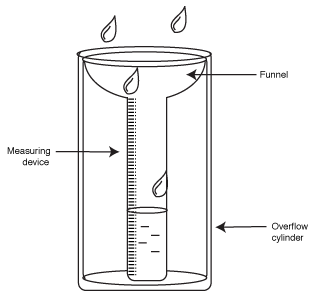Weather: Measuring the Rain
Measuring the Rain
Rain gauges are thought to be the most ancient weather instruments, and they're believed to have been used in India more than 2,000 years ago. A rain gauge is really just a cylinder that catches rain. If an inch collects in the cylinder, it means an inch of rain has fallen. It's that simple. Most standard rain gauges have a wide funnel leading into the cylinder and are calibrated so that one-tenth of an inch of rain measures one inch when it collects inside. The funnel is 10 times the cross-sectional area of the tube. Rainfall as low as .01 inches can be measured with this instrument. Anything under .01 inches is considered a trace. This standard rain gauge is shown in the following figure.

Rain gauge—rainfall measurements.
Weather-Speak
A rain gauge is an instrument that measures the amount of rainfall at a given time interval.
In the more modern era, a common rain gauge is called the tipping bucket type. A bucket doesn't really tip—a pair of small receiving funnels alternate in the collection of the rain. When one fills up with water, it tips and spills out, and the other comes into place to do the collecting. These little funnels tip each time rainfall amounts to .01 inches. The tip triggers a signal that is transmitted and recorded.
Of course, these rain gauges have a problem when the temperature drops below freezing, so the standard versions are heated for the occasion.
What about snowfall? When snow falls on these heated rain gauges, it melts, and a water equivalent is determined. The recorded precipitation is always expressed in terms of rainfall or melted snow. The snow depth doesn't count—unless, of course, you have to shovel it! Sometimes a foot of snow amounts to just a half-inch of water, other times it amounts to three inches of water. It really depends on the water equivalent of the snow, which varies widely.
On the average, 10 inches of snow is equivalent to one inch of rain, but that's only an average. If a rain gauge measures one inch of water during a snowstorm, an observer can't automatically assume that 10 inches of snow has fallen. The snow depth can only be determined the old-fashioned way—by measuring it.
That depth is determined by taking an average of three or more representative spots. A ruler is stuck into the snow, and its depth is recorded. Because of blowing and drifting, the determination of three or more representative locations is not always easy. You would think that there would be a better way, but there really isn't.
Most recently, Doppler radar has been used to estimate rainfall. We'll take a look at this newest technology in the next section.

Excerpted from The Complete Idiot's Guide to Weather © 2002 by Mel Goldstein, Ph.D.. All rights reserved including the right of reproduction in whole or in part in any form. Used by arrangement with Alpha Books, a member of Penguin Group (USA) Inc.







